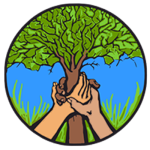When I arrived at the Homestead Skillshare Festival with my husband and daughter, I immediately realized that the childcare space needed some help. Blankets and yoga mats were spread out on the ground, but there was nothing there to engage the kids.
At first I was sad, then angry. Why was the childcare area so neglected? But with the help of a bunch of creative kids and a few parents, we ended up making an adventure out of the oversight.
Since I was already a volunteer, it was only a matter of making sure my station was covered before I decided to take action. I had no idea at all what I would do with the kids, if any were even interested. But I’d embraced that unknowing.
Somehow the childcare area would come to life.
Next door at the greenhouse, I searched for guidance. Meredith, a worker at Hayes Valley Farm, pointed to a nearby field of flowers. “Sometimes we make clover necklaces and chains with kids who visit,†she said. I jumped and thanked her.
Perfect! Now I had a project idea.
But I still needed some kids… and a way to get them excited about clover.“First things first,†I thought, and I went to gather as much clover as I could.
The flowers were huge, some a foot long. Such beautiful possibilities! While gathering them — a slower process than I’d anticipated — I ran into a woman with her six-year-old daughter. I asked the mom and her child if they had any ideas for fun kid activities that would go well with making clover chains. “We can tour the garden,†the girl said excitedly. I loved it: kids solving kid problems.
“Wow, that’s a brilliant idea,†I replied, “but I don’t really know my way around.â€
“I do!†responded the girl. “I can be the Tour Leader. But first, we need to invite some more kids.†My thoughts exactly!
Tour Leader’s mother was just about to give a presentation at one of the festival workshops, so it was excellent timing. Off we ran through the festival crowd.
Recruiting kids was easier than I expected. The children were thrilled for something that centered on them. (Many were bored by then.) The parents and guardians were relieved to be able to participate more meaningfully in the workshops. Some parents chose to join us on the adventure. By the time we met back up at the clover patch, there were about a dozen kids, ages 3 to 10, and three parents. (Well, four including me. But my little one and her pop had already gone home.)
We began by picking clover together, and in doing that came across a variety of other plants. Tour Leader and I whispered to each other, admitting we had no clue what they were. I asked the other kids if they knew. A 3-year-old pointed out some nasturtium, which another youngster told me was edible. “You should try some, it tastes peppery.†I picked some and tried it. Yum! I was already learning a ton.
The edible plant discoveries reminded Tour Leader that she knew where we could find some wild fennel. We chewed some pieces, which the kids agreed tasted a lot like black licorice.
The children had no trouble coming up with activities for themselves along the way. At one point, we took a “Duck, Duck, Goose†break. And later when the kids found a big hammock, they climbed on it and clung tight while one boy pushed them as hard and fast as he could. They were all shrieking and laughing joyously… until they knocked some shingles off a small structure nearby. “Alright, that’s when we stop,†I said.
Throughout our excursion, the kids had been gathering clover and handing it to me. By the time we returned to the childcare area, the bunch of clover was so big I could hardly hold it in my hands. As the children sat on the yoga mats, I set a good-sized clump on each mat and said, “Let’s see what we can make!†We tried figuring out how to make chains. I stumbled upon the way I did it as a child: knotting an end and slipping the next flower through the knot. (Really fun with such huge clover flowers.) The kids were coming up with their own ways and designs, asking for guidance when they got stuck.
Around 2 o’clock, the group was dissipating, so it seemed my work was done. I turned the “Child Care†sign around so it was blank, informally closing it. I was ready to go home and spend time with my own family.
About to leave, I realized I hadn’t said goodbye to the Tour Leader. I saw her with her mom. “Thank you so much,†I told my young friend. “You’re a born leader, and I hope to see you again.†Her expression showed that she was glad I recognized the importance of the afternoon’s fun. She smiled and said bye, and her mom looked really proud.
– article by Amber Yada








